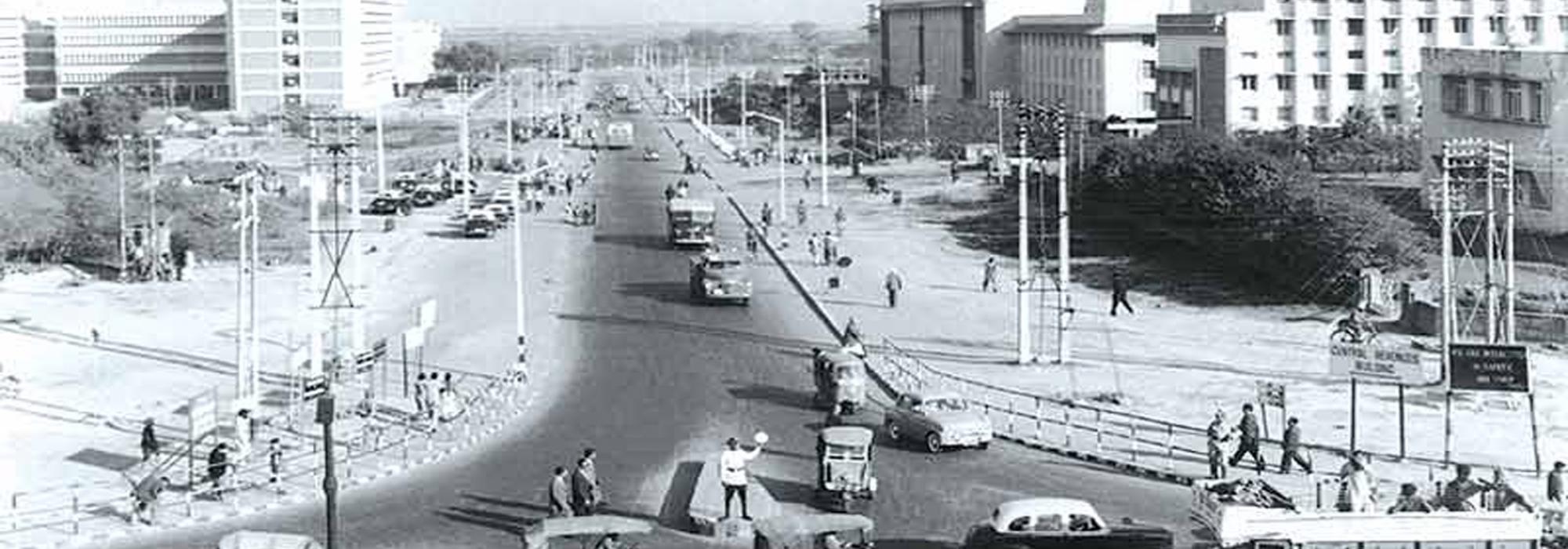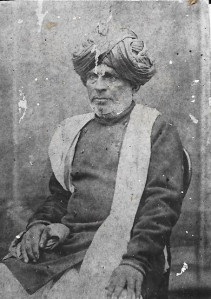Among what I consider my universities, one of the places was a south-facing corner-house ahead of the Sri Narasimhaswamy Temple in Balepet.[1] It may be called the birthplace of the Kannada newspaper. If Mysore were to be the United States, some wealthy person would have purchased the house, created a library or museum with an art collection, and, with the permission of the government, opened it for public use, thereby preserving for posterity the name of the great Bhashyam Tirumalacharya. This was the house of that servant of Kannada.
Tirumalacharya
As far as we know, the ಮೈಸೂರು ವೃತ್ತಾಂತ ಬೋಧಿನಿ (Maisūru Vṛttānta Bōdhinī) was the first Kannada newspaper. Vidvān Bhashyam Bhashyacharya published it first in the June of 1859. It was published every Saturday. The Maharaja of Mysore was its patron. It ran for about four years, till 1864. Bhashyam Bhashyacharya was a Sanskrit scholar. Since he studied at the Wesleyan Mission High School, he knew English too.
His father was Vidvān Bhashyam Tirumalacharya. He was also known as Srishaila Dikshita. ‘Śrīśaila’ is probably the Sanskrit form of ‘Tirumalai.’ The Bhashyam family originally hailed from the Agara village in Ponneri taluk in the Chengalpet district of the Madras Presidency. They were śrīvaiṣṇavas; and they were well-versed in the śrī-bhāṣya commentary.
Bhashyam Tirumalacharya was the founder of a newspaper called ಕರ್ಣಾಟಕ ಪ್ರಕಾಶಿಕಾ (Karṇāṭaka Prakāśikā). This newspaper was started in July 1865. It was published twice a week. The father-son duo—(the father Tirumalachaarya as the proprietor, and the son Bhashyacharya as the editor)—together ran the paper for about a year, till April 1866. In the April of 1866, Bhashyacharya joined government service, as the Kannada translator of the Mysore Gazette. Bhashyacharya continued to be in government service till his death. He died at the age of fifty-one, on 9th November 1884. Tirumalacharya ran the Karnataka Prakashika for another three years. It was discontinued in 1868. Five years later, it was seen again, as a bilingual English-Kannada weekly, published every Monday, and ran without break till 31st October 1898.
After the son joined government service (in April 1866), the father, Tirumalacharya himself ran the newspaper until his death, on 23rd February 1877. After that, Bhashyacharya’s sons, T. V. Venkatacharya and T. C. Srinivasacharya ran the newspaper. T. C. Srinivasacharya was its proprietor.
Among the independently run Kannada newspapers of the Mysore State, the Karnataka Prakashika is perhaps the most ancient. It was not only the first but also a well-known one. I have seen the issues published after 1880 for two to three years. It contained articles in both the Kannada and English languages. In those days, two political parties – the Mysore party and the Madras party – had been started in this region. The Karnataka Prakashika belonged to the Mysore party, while the Madras party had their Bangalore Spectator. It was rumoured that the articles in English in the Karnataka Prakashika were written by a few government officers and their lawyer-friends. One among them, I have heard, was V. N. (mustachioed) Narasimha Iyengar. Circa 1880, Sheshadri Iyer, the then Deputy Commissioner of Tumkur, had filed a defamation lawsuit against the newspaper. I’ve heard that the newspaper suffered losses because of this lawsuit. The Karnataka Prakashika was run fearlessly; the fearlessness was accompanied by dignity. The newspaper included Wire News, Other News, Summary of the Gazette, ‘Inland and Taluk News,’ ‘Occasional Notes,’ and Editorials. The paper was pleasing to look at.[2] It had a writing style that was stately, filled with rhythmic sounds and ornate sentence constructions, and resembled the ಚಂಪೂಕಾವ್ಯ (caṃpūkāvya)—prose-poetry—style of neo-classical Kannada.[3] It was well-suited to the taste and expectation of the people of that era. Just as an example, I present below a passage from the issue published on 27th September 1880. It is about the recent visit of the Maharaja to this town.
“ಎಲ್ಲ ವಿಷಯಗಳಲ್ಲಿಯೂ ನಾವು ದುರಾಕ್ಷೇಪ ಮಾಡತಕ್ಕವರೆಂಬ ಅಪಪ್ರಥೆಗೆ ವಳಗಾಗುವ ಅಪೇಕ್ಷೆ ನಮಗೆ ಯೆಂದಿಗೂ ಯಿಲ್ಲವು. ಅಂತಾ ಅಪಪ್ರಥೆ ಯೀ ದೇಶದಲ್ಲಿ ನಮಗೇನಾದರೂ ಯಿರುವುದಾದರೆ , ಅದು ಸರ್ವಾತ್ಮನಾ, ಸ್ವಾರ್ಥಪರರಾದ ನಮ್ಮ ಅಹಿತರು ಹೇಳುವ ಮಾತುಗಳೆಂದು ಸರ್ವರೂ ತಿಳಿಯಬಹುದು. ಮುಖ್ಯವಾಗಿ, ವರ್ಧಿಷ್ಣುಗಳಾದ ಶ್ರೀಮನ್ಮಹಾರಾಜರವರ ವಿಷಯದಲ್ಲಿ ಮೊದಲಿನಿಂದ ನಾವು ತಿಳಿಸುವ ಸಂಶವೆಲ್ಲ ಅವರ ಶ್ರೇಯಸ್ಸನ್ನು ಕುರಿತದ್ದಾಗಿಯೂ ಅವರ ಪುರೋವೃದ್ಧಿಯನ್ನು ಅದ್ದೇಶಿಸಿದ್ದಾಗಿಯೂ ಅವರ ವೈಭವ ಪ್ರಾಭಾವಗಳನ್ನು ಅವಲಂಬಿಸಿದ್ದಾಗಿಯೂ ಯಿರುವದೆಂದು ನಾವು ಕರಣತ್ರಯ ಶುದ್ಧಿಯಿಂದ ಹೇಳುತ್ತೇವೆ... (ಮಹಾರಾಜರವರು) ಯೂರೋಪಿಯನ್ ಗಳನ್ನು ಬಾಹುವಾಗಿಯೂ ಸ್ವದೇಶೀಯಾರನ್ನು ಸಕೃತ್ತಾಗಿಯೂ ನೋಡುತಿದ್ದರು... ಇಂತಾ ಸಂದರ್ಭದೊಳು ತಮ್ಮಲ್ಲಿ ವಾಲ್ಲಭ್ಯವುಂಟಾದವರು ಕೆಲವರು ವಿನಾ ಮಿಕ್ಕ ತಮ್ಮ ಪ್ರಜೆಗಳ ಸಂಪರ್ಕವೇ ಆತ್ಯಂತಿಕವಾಗಿ ತಪ್ಪಿಸಲ್ಪಟ್ಟಿತು. ಇವರ ಗಾರ್ಡಿಯನ್ ರವರು ಮಹಾರಾಜರನ್ನು ಮುಖ್ಯ ಮುಖ್ಯರಾದ ಯಿಲ್ಲಿನ ಯೂರೋಪಿಯನ್ ರೊಳು ವಿಶೇಷವಾಗಿ ಬಳಕೆಗೊಳಿಸುವುದಕ್ಕೆ ಸರ್ವ ಪ್ರಯತ್ನವನ್ನು ಮಾಡಿದರು... ದರ್ಬಾರ್ ಗಳು ವಗೈರೆ ಪ್ರಬಲ ಸಂದರ್ಭಗಳಲ್ಲಿ ಮಹಾರಾಜರು ಕೆಲವು ಮಾತುಗಳನ್ನು ಸ್ವಭಾಷೆಯಲ್ಲಾಗಲಿ ಇಂಗ್ಲಿಷ್ ನೊಳಗಾಗಲಿ ನುಡಿಯುವರಾದರೆ ಬಹಳ ಶ್ಲಾಘ್ಯವಾಗಿರುವದು. ಅಷ್ಟಕ್ಕೇ ಅವಕಾಶವಿಲ್ಲದೆ ಅವರು ಮೌನವಾಗಿದ್ದದ್ದರಿಂದ ಅವರಿಗೆ ವಿದ್ಯಾಭಾಸಮಾಡಿದ ಕ್ರಮದಲ್ಲಿ ವುಂಟಾದ ಲೋಪವೇ ಕಾರಣವೆಂದು ಯೆಣಿಸಬೇಕಾಯಿತು. ಮೊದಲಿಂದ ಯುಕ್ತವಾಗಿ ವಿದ್ಯಾಭ್ಯಾಸ ನಡೆದಿದ್ದರೆ ಅವರು ತಮ್ಮ ಹೃದಯಸ್ಥವಾದ ಭಾವವನ್ನು ಕೆಲವು ಶಬ್ದಗಳಿಂದ ತಿಳಿಸುವುದಕ್ಕೆ ಶಕ್ತರಾಗದೆ ಇರಲಾರರು. ಮುಖ್ಯವಾಗಿ ರಾಜ್ಯಾಧಿಪತ್ಯ ಮಾಡ ತಕ್ಕವರಿಗೆ ಮೊದಲನೆಯದಾಗಿಯೂ ಅತ್ಯಂತ ಆವಶ್ಯಕವಾಗಿಯೂ ಇರುವ ವಿಷಯ ಅಧಿಕಾರಿಗಳಿಂದ ಉಪೇಕ್ಷಿಸಲ್ಪಟ್ಟಿತಲ್ಲಾ ಯೆಂದು ಬಹಳ ಚಿಂತಿಸುತ್ತೇವೆ. ಈ ವಿಷಯ ಬಾರ್ ಬಾರ್ ಸರ್ವ ವೃತ್ತಾಂತ ಪತ್ರಿಕಾಕಾರರಿಂದಲೂ ಚರ್ಚಿಸಲ್ಪಟ್ಟಾಗ್ಯೂ ಅದಕ್ಕೆ ಅವಧಾನ ಕೊಡದೆಯೂ ತಮ್ಮ ಶೀಕ್ಷಾಕ್ರಮವನ್ನು ತಿದ್ದಿಕೊಳ್ಳದೆಯೂ ಇದ್ದ ಅಧಿಕಾರಿಗಳ ಔದಾಸೀನ್ಯಕ್ಕೋಸ್ಕರ ವಿಷಾದಿಸುತ್ತೇವೆ.”
Bhashyam Tirumalacharya was a prominent Sanskrit scholar. He had earned respect in all learned circles[4] of his time. He was influential among the prominent personages of his times. He undertook many charitable deeds and also performed a yāga.[5] His support was always there for good activities. The first Sanskrit College in Bangalore was started by him, at his residence. It was then relocated to the Tulasi Thota temple. A little later, the school functioned for a while at a garden near the Municipal Park and then, after the Government took over, it was renamed ‘ಶ್ರೀ ಜಯಚಾಮರಾಜೇಂದ್ರ ಸಂಸ್ಕೃತ ಪಾಠಶಾಲಾ’ (Śrī Jayacāmarājeṃdra Saṃskṛta Pāṭhaśālā) and was run in a building that was in the front portion of the Tippu Sultan Palace in the Fort area. Today that building houses a branch of the maternity hospital. Thus, Tirumalacharya was wont to think of public good and received the appreciation of Sri Mummadi Krishnaraja Wodeyar. I must clarify that I have only heard of Tirumalacharya and have not seen him. After him, as mentioned earlier, T. B. Venkatacharya and T. C. Srinivasachaarya managed the Karnataka Prakashika. I do not know anything about them. To summarise, there is no doubt that the Bhashyam family deservedly has a respectable place in the history of the Mysore State.
To be Concluded…
This is the first part of an English translation of the twelfth chapter of D V Gundappa’s Jnapakachitrashaale – Vol. 1 – Sahiti Sajjana Sarvajanikaru. DVG wrote this series in the early 1950s. Edited by Hari Ravikumar.
Footnotes
[1] The word ‘devaḍi’ is an informal reference to a place, like a club, where like-minded people and friends gather to have a good time, in serious conversations or idle gossip, primarily to pass their time with light entertainment. So the title ‘Bhāṣyam Devaḍi’ refers to the house of the ‘Bhāṣyam’ family where friends would come together.
[2] The original has ‘ಅಚ್ಚುಕ್ಕಟ್ಟಾಗಿ’ (accukkaṭṭāgi), which has a range of meanings including ‘neat,’ ‘organized,’ ‘dainty,’ ‘tidy,’ etc.
[3] The original has ‘ನಡುಗನ್ನಡ’ (naḍugannaḍa), which refers to a ‘Middle’ Kannada that came after Classical Kannada (haḻagannaḍa) but preceded modern Kannada.
[4] The original has ‘ವಿದ್ವದ್ಗೋಷ್ಠಿ’ (vidvadgoṣṭhi); while ‘vidvat’ refers to ‘scholarship,’ ‘goṣṭhi’ means ‘assembly,’ ‘society,’ or ‘fellowship.’
[5] Yāga (or yajña) refers to the Vedic ritual that typically involves the raising of agni (sacred fire) in enclosed altars.













































